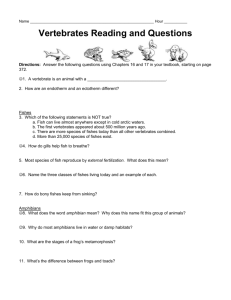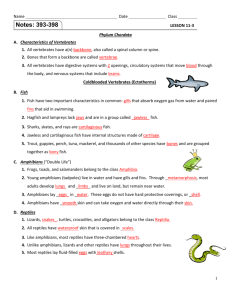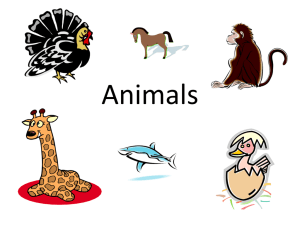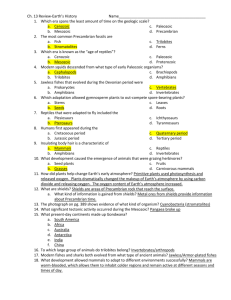Fishes, Amphibians, and Reptiles
advertisement
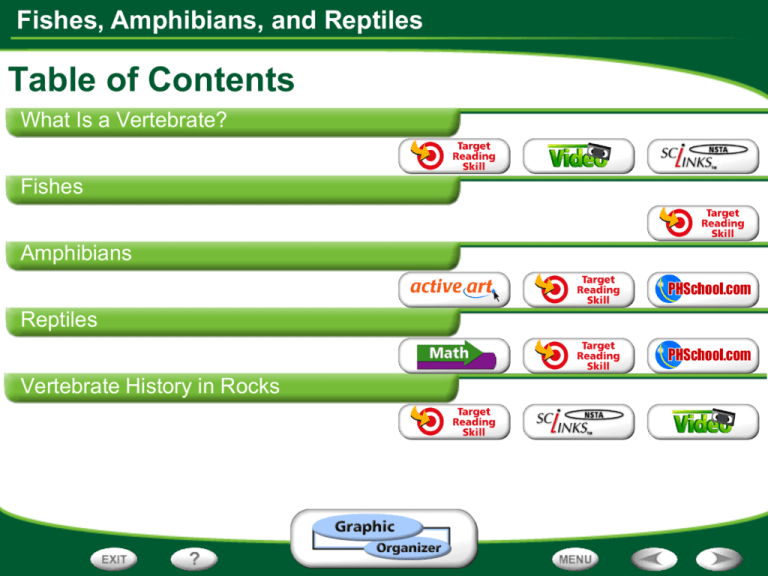
Fishes, Amphibians, and Reptiles Table of Contents What Is a Vertebrate? Fishes Amphibians Reptiles Vertebrate History in Rocks Fishes, Amphibians, and Reptiles - What Is a Vertebrate? Ancient Jawless Fish Look backward in time, into an ocean 530 million years ago. There you see a strange-looking creature—a jawless fish—that is about as long as your index finger. Fishes, Amphibians, and Reptiles Chordate Characteristics •Chordates belong to the phylum Chordata •Members of this phylum include vertebrates and invertebrates •3 common characteristics: a notochord, nerve cord, and gill slits •A notochord is a flexible rod that runs down the back •A nerve cord serves as the connection between the brain and the nerves on which messages travel back and forth •All chordates have pharyngeal slits that either disappear before birth or function as gills for their entire lives. Fishes, Amphibians, and Reptiles Human Embryo Fishes, Amphibians, and Reptiles - What Is a Vertebrate? Characteristics of Chordates This lancelet shows the characteristics of a chordate: a notochord, a nerve cord down its back, and gill slits. Fishes, Amphibians, and Reptiles Characteristics of Vertebrates •Vertebrates have backbones that are part of an internal skeleton (endoskeleton) •Vertebra include any of the bones or segments composing the spinal column, consisting typically of a cylindrical body that allows the spinal cord to pass through it •Vertebrae include all the bones that make up the backbone •Internal skeleton or endoskeleton protects the internal organs of the body, helps give the body shape, and gives muscles a place to attach *Having an endoskeleton allows vertebrates to grow bigger than animals with exoskeletons Fishes, Amphibians, and Reptiles Fishes, Amphibians, and Reptiles Fishes, Amphibians, and Reptiles Quick Review: What are the four major functions of animals? 1. 2. 3. 4. Obtaining food & oxygen Keeping conditions stable Movement Reproduction Fishes, Amphibians, and Reptiles Keeping Conditions Stable •Major groups of vertebrates control their body temperatures in one of 2 ways: •An ectotherm is an animal that does not produce much internal heat so their body temperature changes depending on the temperature of its environment (fish, amphibians, and reptiles) •An endotherm is an animal that regulates its own temperature by controlling the internal heat it produces (birds and mammals) •Endotherms body temperatures do not change much and this allows them to live in many different environments Fishes, Amphibians, and Reptiles - What Is a Vertebrate? Building Vocabulary A definition states the meaning of a word or phrase by telling about its most important feature or function. After you read the section, reread the paragraphs that contain definitions of Key Terms. Use the information you have learned to write a definition of each Key Term in your own words. Key Terms: chordate ectotherm notochord endotherm vertebra Examples: An members All ectothermofisthis an phylum animal whose are called body chordates. does not produce much internal heat. The phylum name Chordata comes from the notochord, a an flexible rod that supports a chordate’s The beaver is example of an endotherm—an back. whose body regulates its own temperature by animal controlling the internal heat it produces. You can see in Figure 2 that the backbone is formed by many similar bones called vertebrae. Fishes, Amphibians, and Reptiles End of Section: What Is a Vertebrate? Fishes, Amphibians, and Reptiles FISH Fishes, Amphibians, and Reptiles Question: What is the name for a person who studies fishes? Answer: Ichthyologist Fishes, Amphibians, and Reptiles Characteristics of Fishes •Fins are thin membranes stretched across a bony support that provides larger surface area for fishes to push against the water • Most fishes have external fertilization where female eggs are released outside the female’s body •In contrast, sharks and some other species have internal fertilization •Nervous/sense organs help fish to find food and avoid predators Fishes, Amphibians, and Reptiles - Fishes Characteristics of Fishes •Most fishes obtain oxygen through gills. •What are gills? •A gill is a respiratory organ found in many aquatic organisms that extracts dissolved oxygen from water Fishes, Amphibians, and Reptiles •Fishes have a closed circulatory and 2 chambered heart •Blood moves from the heart to gills and then to the rest of the body Fishes, Amphibians, and Reptiles Three Major Groups of Fish •Jawless Fish (no hinged jaw) •Cartilaginous Fish (more flexible than bone) •Bony Fish (majority of all fish species) Fishes, Amphibians, and Reptiles Class Agnatha (Jawless Fish) •Cartilagenous •Simplest and oldest known vertebrates •No Jaw •No scales •Scavengers or parasites •Lamprey & Hagfish Fishes, Amphibians, and Reptiles Class Chondrichthyes (Cartilaginous Fishes) •Hinged jaw •Paired fins •Scales •Cartilaginous skeleton •Muscles attached to skin, not skeleton •Skates, Rays, and Sharks Fishes, Amphibians, and Reptiles Class Osteichthyes (Bony Fishes) •Largest group of fishes •Skeleton made of bone and cartilage •Hinged jaws •Paired fins •Hard, protective scales •Covered gills (operculum) Fishes, Amphibians, and Reptiles - Fishes Bony Fishes A bony fish has jaws, scales, a pocket on each side of the head that holds the gills, and a skeleton made of hard bones. Fishes, Amphibians, and Reptiles - Fishes Previewing Visuals Before you read, preview Figure 12. Then write two questions that you have about the diagram in a graphic organizer like the one below. As you read, answer your questions. Structure of a Fish Q. What is a swim bladder? A. A swim bladder is an internal, gas-filled sac that helps stabilize the fish at different depths in the water. Q. What is the function of the tail fin? A. It helps provide the power for swimming. Fishes, Amphibians, and Reptiles End of Section: Fishes Fishes, Amphibians, and Reptiles What is an Amphibian? •Vertebrates •Ectotherms •Both aquatic and terrestrial animals! •Two major groups: 1. Salamanders 2. Frogs and Toads Fishes, Amphibians, and Reptiles - Amphibians What Is an Amphibian? During its metamorphosis from tadpole to adult, a frog’s body changes dramatically! Fishes, Amphibians, and Reptiles - Amphibians Living on Land Many adult amphibians have lungs, a heart with three chambers, and a double-loop circulatory system. The two upper chambers of the heart are called atria (atria is plural for atrium). The ventricle is the lower chamber of the heart where oxygen-rich blood mixes with oxygen-poor blood. Fishes, Amphibians, and Reptiles - Amphibians Sequencing Make a cycle diagram like the one below that shows the different stages of a frog’s metamorphosis during its life cycle. Write each step of the process in a separate circle. Frog Metamorphosis Adult frog Tail is absorbed. Fertilized egg Front legs develop. Tadpole hatches. Hind legs develop. Fishes, Amphibians, and Reptiles End of Section: Amphibians Fishes, Amphibians, and Reptiles What is a Reptile? •A reptile is an ectothermic vertebrate with lungs and scaly skin •Reptiles include turtles, snakes, lizards, alligators & crocodiles •Ancestors of modern reptiles were first vertebrates to live completely outside of an aquatic environment •Land animals must be able to conserve water and the skin, kidneys, and eggs of reptiles have these adaptations •Kidneys are organs that filter wastes from the blood and excreted through urine. •Reptiles have internal fertilization and lay their eggs on land •An egg with a shell and internal membranes that keep the embryo moist is called an amniotic egg. Fishes, Amphibians, and Reptiles - Reptiles Adaptations for Life on Land The membranes and shell of an amniotic egg protect the developing embryo. Fishes, Amphibians, and Reptiles - Reptiles Characteristics of a Lizard This lizard, a Jackson’s chameleon, has many adaptations that help it survive in its environment. Fishes, Amphibians, and Reptiles - Reptiles The Sex Ratio of Newly Hatched Alligators The temperature of the developing eggs of the American alligator affects the sex ratio of the young. (Sex ratio is the number of females compared with the number of males.) Fishes, Amphibians, and Reptiles - Reptiles The Sex Ratio of Newly Hatched Alligators Reading Graphs: At which temperature(s) did only females hatch? 29.4ºC Fishes, Amphibians, and Reptiles - Reptiles The Sex Ratio of Newly Hatched Alligators Drawing Conclusions: What effect does the temperature of developing eggs have on the sex of the baby alligators? The warmer the incubation temperature, the greater the proportion of males. Fishes, Amphibians, and Reptiles - Reptiles The Sex Ratio of Newly Hatched Alligators Calculating: If 100 eggs developed at 31.7ºC, about how many of the young would be male? According to the graph, out of the 50 alligators that were incubated at 31.7ºC, about 40 (or 80%) were males. So 80% of 100 eggs (80) could be expected to hatch as males. Fishes, Amphibians, and Reptiles - Reptiles Extinct Reptiles–The Dinosaurs Dinosaurs were the earliest vertebrates that had legs positioned directly beneath their bodies. Fishes, Amphibians, and Reptiles Fishes, Amphibians, and Reptiles - Reptiles Identifying Main Ideas As you read the information under the heading “Adaptations for Life on Land,” write the main idea in a graphic organizer like the one below. Then write three supporting details that further explain the main idea. Main Idea Reptiles are adapted to conserve water. Detail Reptiles have a thick, scaly skin that prevents water loss. Detail Reptile eggs have a shell and membranes that keep them from drying out. Detail A reptile’s kidneys concentrate wastes before excreting them so that little water is lost. Fishes, Amphibians, and Reptiles Interpretation of Fossils The pattern of vertebrate evolution is branching. Fishes, Amphibians, and Reptiles Graphic Organizer Main Idea The larvae of amphibians are adapted for life in water, and adult amphibians are adapted for life on land. Detail Detail Detail Larvae have tails for swimming; adults have legs for walking. Larvae have gills; adults have lungs. Larvae have one-loop circulatory systems and two-chambered hearts; adults have two-loop circulatory systems and three-chambered hearts. Fishes, Amphibians, and Reptiles End of Section: Graphic Organizer
